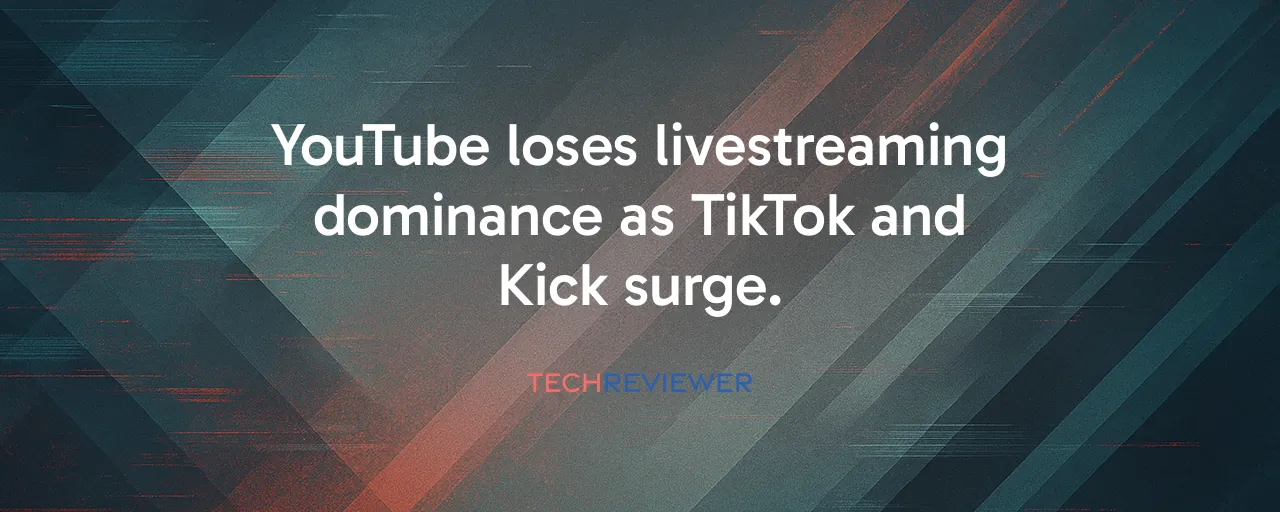A Shifting Livestreaming Landscape
Livestreaming platforms are locked in a fierce battle for viewers and creators. YouTube Live, once the undisputed king, saw its market share slip below 50 percent in Q3 2025, a first in years, with 13.25 billion hours watched, down 10.6 percent from the previous quarter, now holding 45% of the market. Meanwhile, TikTok Live surged to 9.2 billion hours, claiming 31.2 percent of the market, and Kick skyrocketed with a 55 percent growth spurt to 1.7 billion hours. The numbers, pulled from StreamsCharts' Q3 2025 Global Livestreaming Landscape report, signal a turning point. Creators now hold the power, choosing platforms based on revenue splits and audience reach over loyalty to any single service.
This shift isn't just about numbers. It's about a broader change in how creators and viewers interact with platforms. Streamers like Kai Cenat and Ibai Llanos are proving that compelling content can draw massive audiences, no matter where it's broadcast. Platforms are racing to keep up, borrowing features and tweaking monetization to lure talent. But with competition heating up, what's driving this exodus from YouTube, and why are TikTok and Kick gaining ground so fast?
Creators Call the Shots
Streamers are no longer tethered to one platform. Take Kai Cenat's Mafiathon 3.0, a 30-day Twitch event that racked up 82.5 million hours watched with celebrity guests and wild stunts. Its success showed that audiences follow creators, not platforms. Cenat could have streamed on YouTube or Kick and still pulled millions, thanks to his loyal fanbase. Similarly, Ibai Llanos' La Velada del Año V, a boxing event on Twitch, drew 14 million concurrent viewers, rivaling traditional sports broadcasts. These cases highlight a key lesson: creators with strong personal brands can thrive anywhere, forcing platforms to compete for their presence.
Monetization is a major factor. Kick's 95/5 revenue split dwarfs YouTube's 70/30 and Twitch's 50/50 models, letting streamers keep more of their earnings. TikTok Live's virtual gift system, where viewers buy gifts that convert to creator payouts, adds another lucrative draw. Streamers like TimTheTatman, who returned to Twitch after a YouTube stint, saw 6,500 subscribers in a single day, nearly half his YouTube total. The message is clear: creators go where the money flows, and platforms like Kick and TikTok are making it rain.
Mobile-First and Feature Frenzy
TikTok Live's mobile-first approach is a game-stealer. Optimized for smartphones, it lets creators stream on the go, blending short-form videos with live content seamlessly. In Q3 2025, TikTok's 14.9 percent growth to 9.2 billion hours watched showed its knack for capturing younger, mobile-savvy audiences. Features like virtual gifts and real-time interaction keep viewers hooked, while YouTube's desktop-heavy setup feels clunky by comparison. Kick, meanwhile, cuts latency for faster chat responses, creating a more dynamic experience that streamers and viewers crave.
YouTube isn't standing still. In September 2025, it rolled out dual-format streaming, AI-powered highlight clips, and interactive minigames to keep creators engaged. But these upgrades haven't stemmed the tide. TikTok's mobile edge and Kick's lean operation appeal to streamers who want flexibility and quick payouts. As platforms converge, borrowing each other's tricks, the lines between them blur. Soon, the only difference might be the logo, leaving creators to decide based on who pays best and who makes streaming easiest.
Challenges in the Race for Dominance
The livestreaming boom isn't without hiccups. Content moderation remains a headache, with AI systems flagging benign content and human moderators burning out from reviewing traumatic material. Kick's ties to Stake-backed operations raise ethical red flags, deterring some creators despite its generous splits. Viewbotting, where fake viewers inflate stats, costs advertisers millions and erodes trust. Twitch's crackdown on bots in Q3 2025 cut its metrics but didn't solve the problem industry-wide. These issues remind us that rapid growth comes with growing pains.
Viewers, meanwhile, face a fragmented experience. Chat cultures differ, Twitch's interactive emotes outshine YouTube's clunkier system, and platform algorithms favor native content, making multistreamed broadcasts harder to find. Yet, audiences benefit from the competition. More platforms mean better features, like TikTok's mobile accessibility or YouTube's ad-free subscriptions. The catch? Creators must juggle multiple services to maximize reach, a technical hassle that favors those with resources and know-how.
What's Next for Livestreaming
The livestreaming market, stable at 29.45 billion hours watched in Q3 2025, shows no signs of slowing. Forecasts predict the industry will hit $600 billion by 2032, growing at 23.28 percent annually. Creators will keep gaining leverage, using multistreaming tools like Gyre to broadcast across YouTube, Twitch, and TikTok simultaneously. Platforms will fight harder for talent, offering signing bonuses and better terms, while viewers enjoy more diverse content, from gaming to sports and live commerce.
But the future isn't all rosy. Platforms must tackle moderation, privacy, and sustainability to stay viable. Kick's growth hinges on proving its model can last without being dependent on Stake-backed funding. YouTube, backed by Google's deep pockets, may outlast smaller rivals but needs to innovate faster. TikTok's mobile dominance could falter if regulatory pressures mount. One thing's certain: creators like Cenat and Llanos are the new power brokers, and platforms that don't keep up will be left in the dust.
